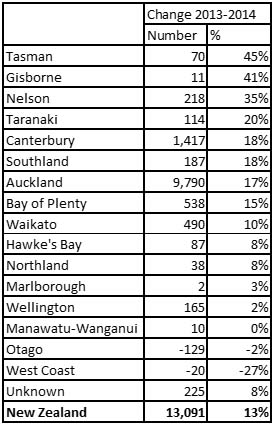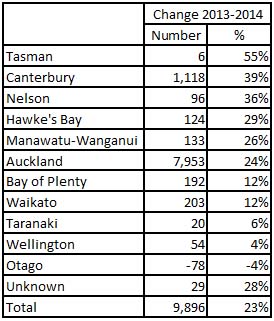
By Shaun Twaddle*

International education is increasingly becoming a key contributor to New Zealand’s economy, especially as international student numbers are forecast to grow from 110,198 in 2014 to be north of 212,000 by 20251.
But while the impact at a national level is resoundingly positive, the impacts at a regional level are much more varied.
The cynic would say that the focus on international education is yet another contributor to increasing regional inequality and that Auckland is the only region really benefiting. But is this actually the case?
Why the increasing regional interest in international education?
Although international student enrolments have increased in recent years, and are likely to continue to increase, the same can’t be said of domestic student numbers of late. Virtually across the board, with the exception of sectors like construction and infrastructure, almost every tertiary education provider I have spoken to over the past several months has referenced the drop-off in domestic students.
It is not surprising then that regions and tertiary education providers are keen to get international students, grab a share of the corresponding economic benefit during their stay, and hopefully turn these students into productive workers in their region post-study2.
It comes as no shock that the two government funded regional growth studies published so far this year, for Northland and the Bay of Plenty, have identified increasing international student numbers as providing opportunities for economic growth. I would be surprised if the next regional growth study report for the Manawatu-Wanganui region, did not come to the same conclusion.
Actually, I would be surprised if this wasn’t the case regardless of the region being focused on.
Who is doing well?
The release of high level regional international student data in Education New Zealand’s recent International Education Snapshot 2014 report resulted in typical ‘spin’ media releases from the regions highlighting how well their region had performed. What piqued my interest, however, was the media release by John Milford, Chief Executive of the Wellington Employers Chamber of Commerce Chief Executive, frustrated by the Wellington Region’s poor performance in terms of international student growth. Despite having two universities, three institutes of technology and polytechnics (ITPs) and many private training establishments (PTEs), the region only managed 2% growth in international students between 2013 and 2014 compared to national international student growth of 13%. It is hardly surprising then that Milford wants the region to make a plan for international education to be one of its highest priorities.
There are a number of ways to look at which region is doing well out of international education.
To answer the question properly, a number of different indicators, such as overall international student numbers and how they have changed over time, the type of study international students are engaged in, where international students are from and the economic contribution of international students all need to be examined at a regional level.
Infometrics is committed to doing the above in detail for our clients, but to get a quick sense of what is going on regionally, consider the following.
Overall international student growth, 2013-2014

Between 2013 and 2014 the Tasman, Gisborne, Nelson and Taranaki regions did fairly well in attracting international students, although growth is coming off a low base in these regions. Canterbury also did well relative to previous years, indicating a pick-up in attracting international students after a drop following the 2011 earthquakes. On the other side of the coin, Otago and the West Coast lost international students, while Wellington and Manawatu-Wanganui, which have relatively large numbers of tertiary students, had only modest growth.
The main takeout, however, is the growth in the number of international students in Auckland. Between 2013 and 2014, international student numbers in Auckland increased by 9790, with Auckland’s share of all international students in New Zealand rising from 60% in 2013 to 62% in 2014.
Is it simply just universities and polytechnics driving growth in certain regions?
Many of you will say, the dominance in Auckland is to be expected as Auckland has a number of universities and ITPs active in the international education space. But if we just look at international students with tertiary education providers in Auckland, this is not the case, with universities and ITPs only accounting for 16% of international education growth among tertiary providers in the region between 2013 and 2014. PTEs, on the other hand, accounted for the other 84% of growth in international students with tertiary education providers. The number of PTEs in Auckland focusing on international students has skyrocketed in recent years – just take a stroll down Queen Street if you don’t believe me.
This begs the question – is Auckland’s growth in international students at PTEs representative of what has occurred in other regions? Well, not uniformly – Canterbury, Nelson, Hawke’s Bay, Manawatu-Wanganui also had strong growth between 2013 and 2014, largely due to an expanding PTE presence in these areas. However, as was the case with overall international students, the number of international students at PTEs in Otago declined, while growth at PTEs in Wellington was negligible. This underperformance in Otago and Wellington was largely as a result of static to declining PTE capacity in these areas.
Growth in international student at PTEs (including English Language Schools), 2013-2014

Auckland has done well relative to other regions and has an advantage in attracting PTEs by virtue of its sheer size, large East Asian and Indian populations and being New Zealand’s ‘gateway’. This helps in attracting higher spending Chinese and Indian students.
So how do other regions catch up to Auckland?
As we all know, this is easier said than done. However, regions need to ensure they are not only putting resources into growing international student numbers at existing tertiary providers and schools, but they should also look at ways of encouraging PTEs to set up shop in their region. One possible avenue to consider is making regions more attractive by encouraging English language schools to your region by outlining the benefits to international students of creating pathways for international students from targeted PTEs to higher level ITPs and Universities.
But before regions go about developing plans to attract more PTEs, regions need to be aware of the evidence and trends over time in terms of international student and PTE numbers in their region, the types of international students being attracted, which students generate greater ‘value’, and the economic contribution of international students in their region. With the increased focus on international education over the past few years our understanding of these issues, data collection and data availability has improved substantially. This enables us to conduct more robust analysis of national and regional trends in international education.
---------------------
[1] Education New Zealand – Leadership Statement for Tertiary Education.
[2] A 2010 Department of Labour study found that shows that 23% of foreign fee-paying university students (who enrolled from 2003 to 2006) made the transition to work by 2009, and 15% made the transition to residence.
---------------------
Shaun Twaddle is a senior economist at Infometrics. This article originally appeared in Infometrics’ newsletter and has been republished here with permission. You can contact him here »
We welcome your comments below. If you are not already registered, please register to comment
Remember we welcome robust, respectful and insightful debate. We don't welcome abusive or defamatory comments and will de-register those repeatedly making such comments. Our current comment policy is here.